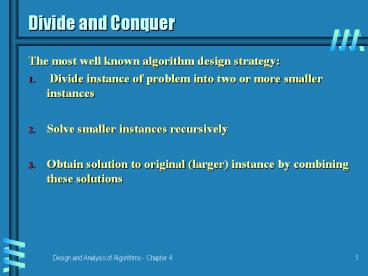Divide and Conquer - PowerPoint PPT Presentation
Title:
Divide and Conquer
Description:
Design and Analysis of Algorithms - Chapter 4. 1. Divide and Conquer ... Design and Analysis of Algorithms - Chapter 4. 10. Quicksort Example. 15 22 13 27 12 10 20 25 ... – PowerPoint PPT presentation
Number of Views:99
Avg rating:3.0/5.0
Title: Divide and Conquer
1
Divide and Conquer
- The most well known algorithm design strategy
- Divide instance of problem into two or more
smaller instances - Solve smaller instances recursively
- Obtain solution to original (larger) instance by
combining these solutions
2
Divide-and-conquer technique
a problem of size n
subproblem 2 of size n/2
subproblem 1 of size n/2
a solution to subproblem 1
a solution to subproblem 2
a solution to the original problem
3
Divide and Conquer Examples
- Sorting mergesort and quicksort
- Tree traversals
- Binary search
- Matrix multiplication-Strassens algorithm
- Convex hull-QuickHull algorithm
4
General Divide and Conquer recurrence
- T(n) aT(n/b) f (n) where f (n) ? T(nk)
- a lt bk T(n) ? T(nk)
- a bk T(n) ? T(nk lg n )
- a gt bk T(n) ? T(nlog b a)
- Note the same results hold with O instead of T.
5
Mergesort
- Algorithm
- Split array A1..n in two and make copies of
each half - in arrays B1.. n/2 and C1.. n/2
- Sort arrays B and C
- Merge sorted arrays B and C into array A as
follows - Repeat the following until no elements remain in
one of the arrays - compare the first elements in the remaining
unprocessed portions of the arrays - copy the smaller of the two into A, while
incrementing the index indicating the unprocessed
portion of that array - Once all elements in one of the arrays are
processed, copy the remaining unprocessed
elements from the other array into A.
6
Mergesort Example
- 7 2 1 6 4
7
Efficiency of mergesort
- All cases have same efficiency T( n log n)
- Number of comparisons is close to theoretical
minimum for comparison-based sorting - log n ! n lg n - 1.44 n
- Space requirement T( n ) (NOT in-place)
- Can be implemented without recursion (bottom-up)
8
Quicksort
- Select a pivot (partitioning element)
- Rearrange the list so that all the elements in
the positions before the pivot are smaller than
or equal to the pivot and those after the pivot
are larger than the pivot (See algorithm
Partition in section 4.2) - Exchange the pivot with the last element in the
first (i.e., sublist) the pivot is now in its
final position - Sort the two sublists
9
The partition algorithm
10
Quicksort Example
- 15 22 13 27 12 10 20 25
11
Efficiency of quicksort
- Best case split in the middle T( n log n)
- Worst case sorted array! T( n2)
- Average case random arrays T( n log n)
- Improvements
- better pivot selection median of three
partitioning avoids worst case in sorted files - switch to insertion sort on small subfiles
- elimination of recursion
- these combine to 20-25 improvement
- Considered the method of choice for internal
sorting for large files (n 10000)
12
QuickHull Algorithm
- Inspired by Quicksort compute Convex Hull
- Assume points are sorted by x-coordinate values
- Identify extreme points P1 and P2 (part of hull)
- Compute upper hull
- find point Pmax that is farthest away from line
P1P2 - compute the hull of the points to the left of
line P1Pmax - compute the hull of the points to the left of
line PmaxP2 - Compute lower hull in a similar manner
Pmax
P2
P1
13
Efficiency of QuickHull algorithm
- Finding point farthest away from line P1P2 can be
done in linear time - This gives same efficiency as quicksort
- Worst case T( n2)
- Average case T( n log n)
- If points are not initially sorted by
x-coordinate value, this can be accomplished in
T( n log n) no increase in asymptotic
efficiency class - Other algorithms for convex hull
- Grahams scan
- DCHull
- also in T( n log n)
14
Strassens matrix multiplication
- Strassen observed 1969 that the product of two
matrices can be computed as follows - C00 C01 A00 A01
B00 B01 -
- C10 C11 A10 A11
B10 B11 - M1 M4 - M5 M7
M3 M5 - M2 M4
M1 M3 - M2
M6
15
Submatrices
- M1 (A00 A11) (B00 B11)
- M2 (A10 A11) B00
- M3 A00 (B01 - B11)
- M4 A11 (B10 - B00)
- M5 (A00 A01) B11
- M6 (A10 - A00) (B00 B01)
- M7 (A01 - A11) (B10 B11)
16
Efficiency of Strassens algorithm
- If n is not a power of 2, matrices can be padded
with zeros - Number of multiplications
- Number of additions
- Other algorithms have improved this result, but
are even more complex































